Front Cover
TAC Table of Contents
Contact Information
|
I grew up reading Superman comic books in the early 1960s. The Man of Steel was featured in eight different DC titles, and it was a great time to be a fan - even if I couldn't afford every issue! Very few of the ones I did buy survived into the present day, but I've managed to revisit quite a few of the stories, compiling a set of faves that live down in the basement. Here are reflections on some of those great old comics.
I wish I could remember the exact issue of Superman for which I first plunked down my own ten toughly negotiated cents. Who knew it would be so hard to recall some 50 years later, or seem so important? To be sure, misty memories of early exposure to the Man of Steel's literary exploits still glimmer. There was a family visit to the home of church acquaintances, where the son - a few years older than me - had a copy of Action 259 (1959) among his possessions (not that I noticed the issue number, but who could forget that image of Superman with his brain so evolved that his bald head looked a lot like a giant - oops, sorry!- this is a family-friendly site). I also recall a vacation with a day-long drive up the 95 (or whatever road existed) corridor, during which the very first Bizarro story - later traced to Superboy 68 (1958) - somehow wound up in my hands, perhaps purchased in desperation by my parents at one of our splurgey Howard Johnson's stops. And, as I've perused some of the old Silver Age sagas from the vantage point of the new millennium, Superman 139 (1960), with its Untold Story of Red Kryptonite, rings some ancient bell. Still, I can't get a handle on just which issue counted as my first, commanding 67% of my weekly allowance. But I do clearly recall one early purchase, including discovering the issue in the spinner rack, getting my hands physically on it, and savoring the cover and title in disbelieving joy. "The Complete Story of Superman's Life!" proclaimed Superman 146, dated July 1961. Color me eight years old, and boy, did Mort Weisinger and company have my number! The cover blurbs addressed plenty of stuff I needed to know, and the quickest of flip-throughs revealed much, much more. The costume! The glasses! The Kents on their deathbed! I'd been a fan just long enough for this to be perfect timing. I'd have probably paid a whole quarter for it - if I'd had one. |
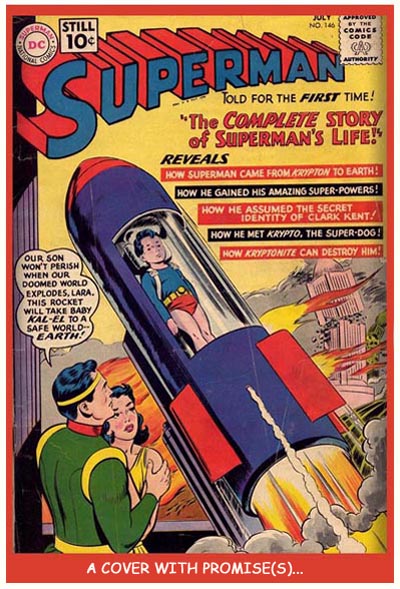
|
Maybe Editor Weisinger missed a marketing opportunity by charging only 10 cents for this fact-packed issue, but he certainly succeeded in putting down a strong foundation for the Superman family mythos, one he'd already begun to build and would expand upon greatly as the Sixties unfolded. Michael E. Grost, writing for his excellent Classic Comic Books web site, notes that this story "is clearly written to educate new readers into the whole background of the Superman family of comic books. It proceeds with step by step, methodical deliberation through every element of the Weisinger world [and] forms a sort of logical backbone to the Superman series as a whole." The story also performs some necessary housekeeping for the Weisinger era, which in 1961 was beginning the rise to its zenith. Continuity problems large and small had beset Superman in the comics practically since day one. One notable example involved the very existence of Superboy, alive and kickin' since the 1940s, but never acknowledged in a Superman origin story until now. |
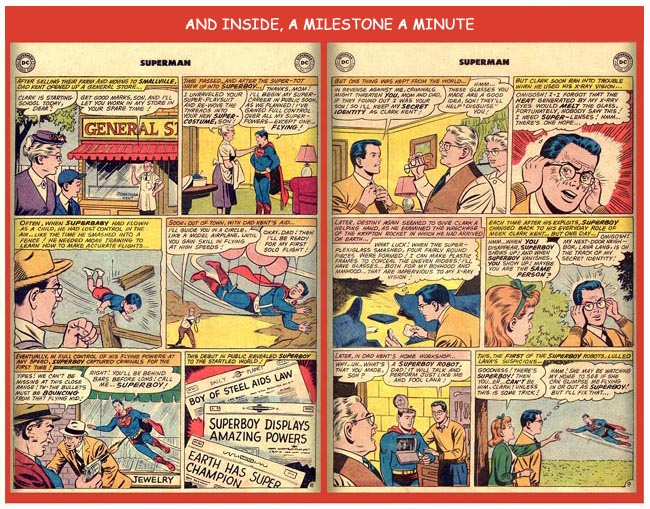
Superman 146 afforded Mort and the gang an opportunity to say: This is the way it was and is! Anything else you know is probably wrong. Not that I was tracking on any mythos malarkey that fine summer day, back home from Blair's Drugstore with my prized purchase. I was too busy happily working my way through the dizzying display of Super-events. In just 13 pages (admittedly a long story in those days), we witness Kal-el AND Krypto's deliverance from Krypton's destruction, the adoption and upbringing of young Clark Kent, the early training of Superboy - as well as the origins of his costume, robots, and glasses, a dissertation on the source of our hero's powers, the reunion with Krypto, and, well - more than can comfortably fit in even this laundry list of a sentence. As we used to say at the end of all those oral book reports in grade school: if you want to know more, you'll have to read the book. "The Story of Superman's Life" - no matter any unstated motives of its creators - effectively said to this young reader: Welcome to the family. Superman may have secrets from the rest of the world, but not from you - you're in! That was an important message to an introverted, book-loving kid, and one that would keep me parting company with my dimes and pennies for several years to come. "The Story of Superman's Life" appears reprinted in DC's trade paperback Superman in the Sixties. The Classic Comic Books web site, noted above, can be found at http://mikegrost.com/comics.htm It features thoughtful analysis of stories from most of the Superman-related titles of the Silver Age. |
|
In case of fire, it's family first. Then the cats and Layla the dog - who's a half step in front of me whenever there's excitement anyway. After that, no set plan. But sometimes I think I'd be hard-pressed not to run down to the basement and grab the big blue binder with all eight Giant Superman Annuals inside. I mean, do the math: 640 pages of classic Supe stories saved from the flames for my sons and future grandchildren, and I'd still have a hand free to grab the good silver on the way out. 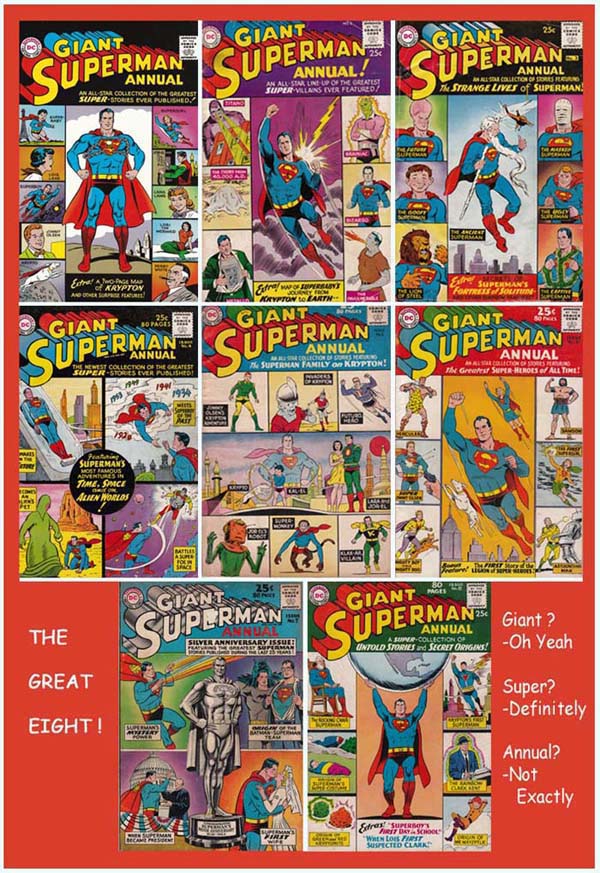 What was the special attraction of these amazing books - then and now? They had the power to incite a generally low impact 10 year old to lobby hard for an allowance increase to make the 25c "cover charge". Those same covers could make a grown man cry when he saw their images on ebay 40 years later, years during which he'd begun to wonder if the books had really existed - or were products of a wishful imagination. Let's start with those covers then. I am a sloppy person who craves order. And were the Annual covers ever orderly! Maybe a little too Brady Bunch for some readers, but I liked how those neat little boxes put it all up front. And the art was clean - and new - Curt Swan: the characters may have been established and the stories reprints, but each got a fresh Swan rendering to fit the cover. While they weren't really "Annuals", appearing as they did every six months, they were unquestionably "Giant". Eighty pages was more comic book than I could read in a day - or even two - unless we're talking sick in bed. One annual equaled the literary heft of three regular comics, with an extra story to spare. It was the stories, after all - once the purchase had been financed and the dual excitement of the cool cover and actual ownership had faded a bit - that it was all about. While it would be great fun to discuss all the stories from all the annuals, that would use up quite a bit of TAC's website - assuming I could actually complete such a column in this lifetime. Instead, we'll peek inside the marvelous cover (have I mentioned I like the covers?) of Giant Superman Annual #1. There's a generous offering of tales, seemingly targeted at exactly the demographic I represented in the summer of 1960: a relatively new but avid Superman fan, hungry for history and mythos-malleable. Note the dutiful reprint, for example, of Supergirl's origin story, which had first been published just a little over a year earlier. This might seem superfluous from our long distance lens in the 21st century, but that story was new to me! More to the point: Editor Mort Weisinger and company seemed to be designing this edition as a Superman Family Primer; this could serve as your first ever Superman experience, and you'd be on solid ground for the rest of the Sixties. The placement of the very first story in the very first annual, then, is both touching and calculated. As Michael Grost (I borrowed from above as well) notes on his Classic Comic Books site, "Superman's First Exploit" fills in here as an origin tale. The most recent Superman origin story at that time dated back to 1948 and hardly met the new and revised factual specs of the Weisinger era mythos ( "The Story of Superman's Life", discussed above, was still a year away). "Exploit", from 1956, does feature a one page review of Kal-el's departure from Krypton, and even establishes a couple of Silver Age conventions: Superman's power of super-recall, which has seemingly lain dormant all these years until he's prodded to remember for the first time his last moments on his home planet; and the re-telling of key Super-events with new elements added retroactively, here an account of little Kal-el actually leaving his spaceship en route to Earth! Even with all that heavy lifting, "Superman's First Exploit" is an engaging yarn with a good-hearted twist at the end. With this sort-of-an-origin tale established, the key faces and places of the Superman family take their orderly turn in the reprint spotlight. And if every story isn't great, it's still a wham-bam lineup. There's the cover story from Lois Lane #1, the "Untold" origin of Lori Lemaris, the afore-mentioned Supergirl debut, and the first tale to feature the arctic Fortress of Solitude, which some readers consider the first Silver Age Superman story. The goofy side of the Silver Age is also well represented, with a "fat Lois" story that screams political incorrectness, an "Execution of Krypto" yarn, and two wacky Jimmy Olsen tales, in which he respectively materializes in Superboy's Smallville and grows a futuristically large brain (well in advance of similar cranial expansions for Supe and Lois). Yep, more than you could read on a school day! Although the cover of the first annual proclaimed "the greatest super-stories ever published", a more descriptive blurb might have been "All in the Family". Themes were more clearly delineated in the next seven annuals, and generally in the "80 Page Giants" that proliferated in their wake. Annual #2 gave us Great Villains, for example; #4 featured tales of time and space; #5 was an all Krypton volume; #6 collected one-shot super-powered characters; and #7 was a Silver Anniversary edition with a particularly handsome cover. My personal faves were #3, with its Strange Lives of Superman theme yielding a nice mix of stories, and the finely detailed Untold Stories of #8 - I was always a sucker for something like "The Untold Origin of Superman's Belt Loops". I've found over the years that reading about these stories invariably makes me want to go back and read the stories themselves. Now I know that writing about them has the same effect. Hmm, 640 pages - too many for a workday. Meanwhile, I think I'll move that blue binder closer to the front door. First editions of the original Giant Superman Annuals show up on ebay, other online sellers, and in comic shops. Annual #1 was reprinted in its entirety by DC in 1998, and copies surface in the same markets. Covers and story listings for all the annuals can be viewed http://www.dcindexes.com/ . Michael Grost's writing on Superman comics can be found at http://mikegrost.com/comics.htm . The Walker Family Fire Evacuation Plan does not currently exist in printed form. 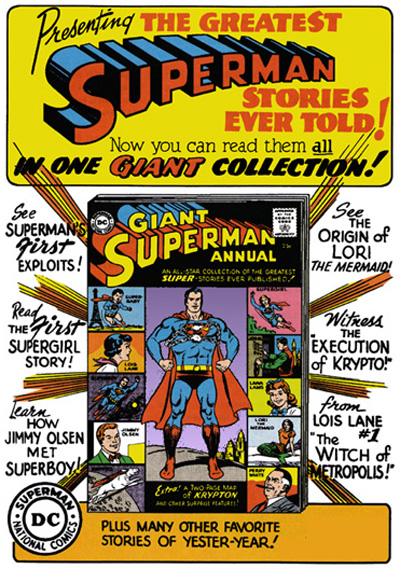
|
|
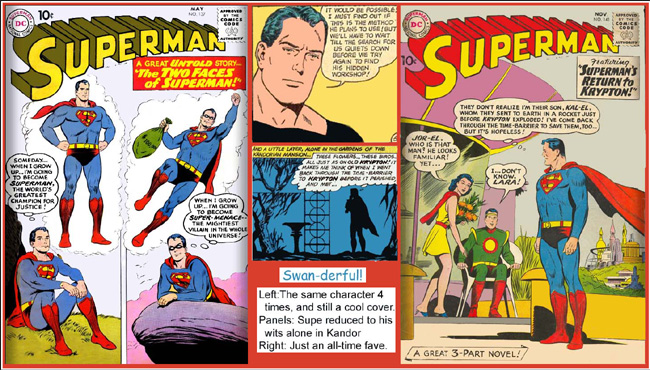 But beyond the obviousness of the subject matter, I've spent a lot of time wondering what to say. There is the problem of writing about something visual, although art and movie critics do it all the time (so do writers, come to think of it). And there is the challenge of saying something new: Google "Curt Swan" and you will find scads of informative and visually delicious sites, including a nice look back by the artist himself. As I make my way toward my own thoughts, here are some Curt Swan basics: Born in 1920 and growing up in Minneapolis, Mr. Swan's artistic gifts were readily apparent to his teachers, who recruited him for many school-related projects. He even designed, scripted, and illustrated his own single-copy comic book as a boy, although an overt passion for the comics is not evident in his interviews and recollections. In 1940, he went from the National Guard into the Army and was shipped to Ireland, where he morphed himself from mess sergeant to illustrator for Stars and Stripes. After the war, the recently married Mr. Swan settled in NYC to look for work, and at the suggestion of a friend, wound up taking a job at DC comics. He felt this might be a two-year venture, and in fact left early on to work for an ad agency. The money was better at DC, however, so he returned and, by his account, learned how to stand up to the problematic behavior of boss Mort Weisinger. In 1955, having drawn a slew of DC characters including regular
stints with Superboy and Jimmy Olsen, Swan was assigned to work
on a 3-D project with established Superman artists Wayne Boring
and Al Plastino. While The Three Dimensional Adventures of
Superman ran for only one issue, Weisinger liked Mr. Swan's
work and, in the artist's words, "soon after that he put
me on Superman steady." 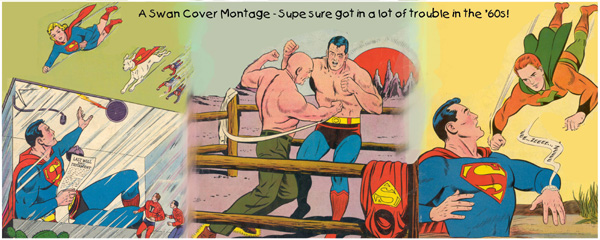 Steady all right! Mr. Swan drew every cover of Superman, save two, starting in 1957 and going through the 1960s. The artwork on the stories inside shifted in those years from mostly Boring to predominantly Swan. The pattern was similar with Action Comics, and Mr. Swan also continued to keep his deft hands in the adventures of Jimmy Olsen (the first 108 covers!) and Superboy. He not only survived the Weisinger reign at DC, he thrived with the next editor, Julius Schwartz, and continued as a principal artist with the Man of Steel until the scripted continuity that marked the Silver Age finally ended in 1986. DC continued to use Mr. Swan's services on various occasions, with some of his final drawings-of Brainiac-appearing shortly after his death in the summer of 1996. My connection with the art of Curt Swan is an emotional one. First, understand that I am forever hopeless with pencil, ink, and crayons. I would draw the standard A-frame house in elementary school and the chimney would always slant at the same angle as the roof. Know, too, that during my early years with Superman comics, I didn't spend time considering that anyone DREW them at all. The pictures were part of the story, and it was all just THERE. Yet with all that ignorance and non-artistic aptitude in play, today I know it was the art of Curt Swan that drew me toward Superman and his friends and antagonists week after week. When I see those classic covers now, I get a twinge that reconnects me with the eight-year-old standing at the spinner rack in Blair's Drugstore. Now as then, I can study the cover of Superman #149 "The Death of Superman" and wish it weren't so. There are panels in "The Dynamic Duo of Kandor" (Supe and Jimmy as Nightwing & Flamebird) so familiar that it doesn't seem possible I laid them aside for forty minutes, much less forty years. When I re-visit old stories drawn by Wayne Boring or Al Plastino, I often think "hmmm..", but with Mr. Swan's work, it's always "Ahhh!" Mr. Swan's artwork could accomplish a dozen things to improve a story: the script seemed more believable, Superman appeared heroic AND human, Jimmy could look thoughtful, Lois came across as someone capable of acting like an adult, Luthor's expressions suggested a multi-layered personality, Krypto looked like a real dog, and the shenanigans in the Mr. Mxyzptlk stories-Mr. Swan's favorites-while always ludicrous, were rendered quite realistically. Oh, and Supergirl. Jim Mooney's somewhat cutesy rendition of the Girl of Steel carried her through all those issues of Action in the 1960s, for better or worse. But Mr. Swan's version suggests a much more interesting character-more depth, a subtler beauty, potentially more heroic. With the benefit of a long distance lens, this comic book lover can see that Curt Swan's art was the glue that held together the greatness of Superman's saga in the sixties. He drew the Superman many of us remember, not as a cartoon character, but as a compassionate and-Kryptonian heritage notwithstanding-very HUMAN super-hero. For myself, I can't imagine this connection occurring with any other DC artist of the era. Girls and soul music finally led me away from comic books as a young teen. As much as anything else, Curt Swan's art has drawn me back. For Curt Swan on the web, check out: Who Drew Superman, at http://www.supermanartists.comics.org/superart/superart.html . There are examples from Superman artists, including details on who inked for whom. Eddie Zeno's bio is a comprehensive read and features some stunning color collages. 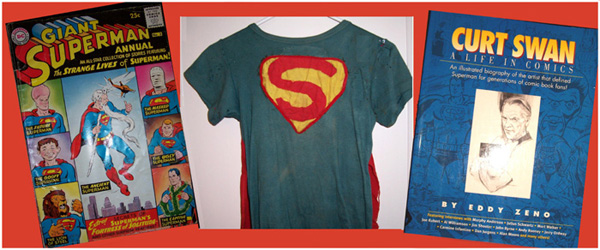 |
|
Here's a thing I did once I finally got to high school-perhaps you did it, too: I studied the yearbooks from the previous couple of years, the ones with pictures of the seniors who'd since graduated and therefore with whom I would NOT be attending school. Perhaps that was just as well, because those older kids seemed impossibly cool, good-looking, and self-assured. To quote Animal House author Chris Miller noting the college version of this dynamic: There Were Giants Then. Even as my own class grew older, cooler, and arguably more good looking-eventually and astonishingly becoming seniors ourselves-a part of me knew we'd never achieved the lofty heights of wholeness those older kids inhabited. I had an analogous experience in my relationship with comic books. I began buying and reading in early 1960 (age 7), but thanks to DC's own version of the yearbook-their so-called Annuals-I was exposed to hearty helpings of stories that had originally run in the years before my time. And boy, were they cool! 1958 and '59 were amazing years for Superman and his friends, family, and foes. As Editor Mort Weisinger's staff lay the groundwork for a mythos-like continuity that would stay at least partly in tact for nearly three decades, those two years alone saw the introduction of Supergirl, Brainiac, the bottled city of Kandor, the Fortress of Solitude, the Legion of Superheroes, Lori Lemaris, and that Seinfeld fave - Bizarro. Superman himself (including his teenage self) was gearing up to appear in eight different titles that each published between 8 and 12 issues a year, so there were plenty of slots in which these new characters and conventions could be of great utility. One of the best stories from the late '50s-and my favorite-involved
none of the aforementioned supporting cast or contrivances. In
fact, Superman is notably on his own, with much of what would
normally appear as dialogue replaced with Supe's balloon encapsulated
thoughts. For me, Superman's New Face (Action 239, April
1958) evokes some of the stark hopelessness of the great TV episode
Panic in the Sky, even more so than its comic book equivalent
(discussed elsewhere on TAC). 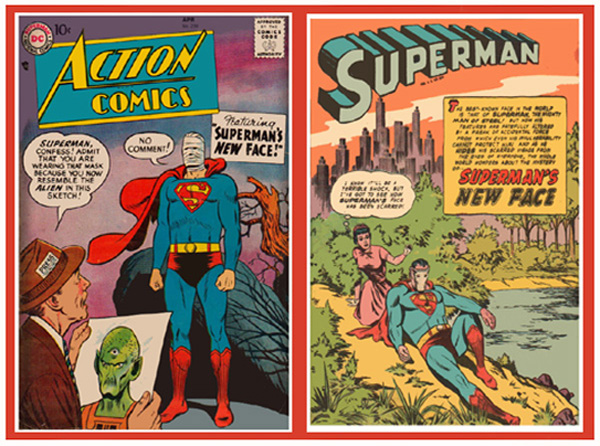 The Man of Steel's bandaged visage on the cover is no doubt a salute to the classic film version of The Invisible Man, and represents a stock gimmick of the era: a visual tease intended to make the potential buyer wonder, "What's going on here?" (more typical examples came to include any "cast" regular besides Supe with sudden super-powers, any of his friends shockingly appearing as his sworn enemy, and anyone-including Supe-with a futuristically enlarged brain and the obligatory light bulb shaped head). But, gimmicks aside, Superman has a serious problem. He's flown a defective experimental atomic generator away from its earthly confines so it can explode "harmlessly in the stratosphere." However, the unit was powered in part by kryptonite (doh!) and the explosion has scarred the chiseled good looks of the Man of Steel. His angst has less to do with vanity than protecting the secret of his alter ego, Clark Kent. Until a solution can be found, Superman will have to hide his disfigurement from the public. And his readers. The nature of his scarring and his full facial appearance is not revealed to us until late in the story. Whenever Supe is between full bandage wraps or, at one point, a scrap metal mask (nothing says "I'm depressed" quite like covering your mug with part of a sunken ship!), we see his face only in shadow. It's an effective approach and, in the hands of artist Wayne Boring, less hokey than it sounds. My love of Curt Swan's art is well documented elsewhere on this page, but I find Boring's stark and angular style right for this story. |
| Superman's dilemma is treated with great gravitas, both in the telling and within his own comic book habitat. His bleak mood and the concern of the world at large are so effectively conveyed that we may not even stop to wonder what the big deal is, at least as far as the planet's concerned: he CAN keep on being Superman, right? Of course, Supe's concern is salvaging his Clark Kent persona, and with that in mind, he runs through a smorgasbord of cataclysmic facial |
|
|
treatments in futile attempts to erase the kryptonite scars. Finally, he can shirk his Daily Planet duties no longer, and the vast weight of this tale comes to balance neatly on a small strip of adhesive tape that Clark affixes across his forehead. We are so amazed that we may, again, fail to ask: What was up with covering his whole face? The riddle's answer straddles the fence between clever and DC-silly, but, in my view, never quite falls off into the latter camp. In lieu of a Spoiler Alert, I invite you to check out this post at the Adventures of Superman discussion board at yuku.com. We can talk about how Supe faces down this earthshaking problem-not to mention how it all fits under one band-aid! |
|
(or The Spurious Super-Sibs) 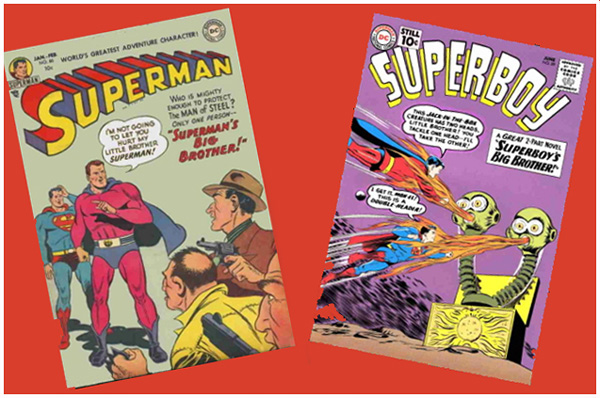 First, the dirty laundry: DC Comics recycled stories. The pair of tales we're about to discuss features the same concept, the same key plot device, and even some identical narrative and dialog. I'm no expert on how often this happened, but in searching the net for images of our featured covers, I practically tripped over another pair of shared stories. The impetus for re-using a reasonably good story concept was likely the very reason Superman's editor rarely if ever got busted for it: reader turnover. DC's real-life version of Perry White, Mort Weisinger, figured he had any given kid's attention for about 5 years (dead on in my case); why not dust off a yarn from the previous decade? So here we are with two tales of young men who each seem to be Kal-el's big brother. They share identical evidence, which also serves as our evidence that someone pulled 1953's "Superman's Big Brother" (Superman #80) as a source for 1961's "Superboy's Big Brother" (Superboy #89). In both tellings, Clark's super-senses detect an unearthly rocket on a crash course with his adopted planet. Superman/boy intercepts the craft, ensuring a soft if fiery touchdown, duly noted by our hero as reminiscent of his own Earth landing. An unconscious, perfectly human-looking alien is found inside, along with a star chart inscribed with (ulp!) Jor-el's handwriting! Supe's surprise is compounded by the text of his dad's notes, which indicate that the map is to serve as a navigational aid for this trip to Earth by... his son! And there you have it: the arguably thin strip of evidence Superman and Superboy each uses to conclude that the big, amnesiac guy in spandex snoozing in the rocket - Halk Kar in the earlier tale, Mon-el in the later - is his brother. 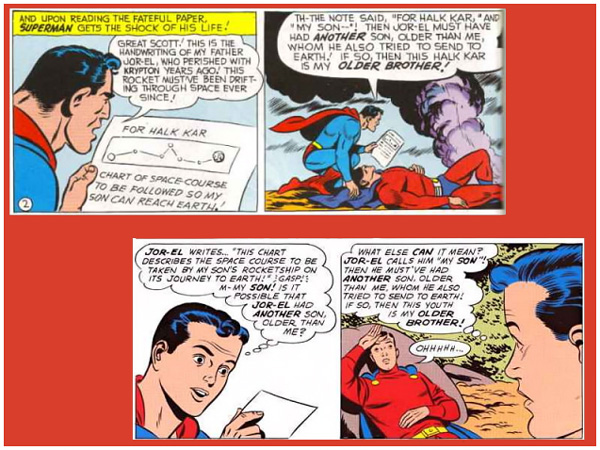 Fortunately for this article, the stories' similarities, for the most part, end there as well. And comparing the differences is at least as fun as noting DC's in-house plagiarism. Rule #1: don't get hung up on continuity. In Superman's world, most of the Fifties are to the Sixties as apples are to Applejacks. Our earlier story here is very pre-Silver Age, so we get nowhere wondering why Superman doesn't recall the "big brother" experience recounted in the Superboy tale. |
|
What we can note with interest are the different personalities displayed by Superman and his teenaged earlier self. Superman is unfailingly deferential to the man he believes is his older sib. As Halk Kar's powers slowly wane, Supe secretly covers the big guy's blue-trunked butt in one super-deed after another, even though ol' Halk is a bit of a blowhard whom we may not mind getting a little comeuppance. In contrast, Superboy presents as a narrow-thinking jerk. When the holes in his "he's my brother from Krypton" construct start to appear, Superboy suspects Mon-el of a plot to deceive him. |
|
|
This is apparently an easier route for the Boy of Steel than stepping back to recall that he himself connected the dots on the El family theory. Instead, he sets out to bust Mon-el's chops, and comes within a minute or two of poisoning the guy to death. Because he's unwittingly put Mon-el at death's door, Superboy must whisk through the last page or so of the story tapping every bit of his super-teenaged ingenuity. At the comparable point in his own tale, Superman has no such dilemma to solve and is allowed the space to show a good deal of affection toward Halk, along with the bittersweet sorrow that comes with the discovery of his "brother's" true identity and Halk's need to return to his own world. Superman has played a supporting role in this tale in more ways than one, but we leave the story impressed with his loneliness and longing. 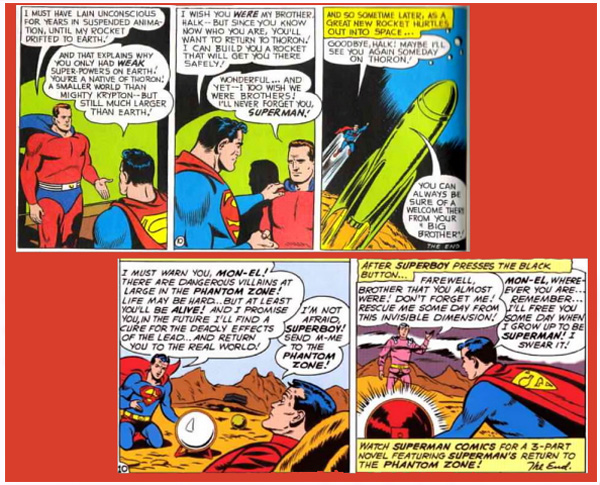 Superboy, on the other hand, escapes his yarn without a proper apology to Mon-el, making only a hasty promise to find a cure for the cosmic lead poisoning he induced in the poor fellow - this as he banishes Mon-el to the Phantom Zone in the story's final panel! Indeed, much like Mon-el's luck, the tale seems to just run out. Quite an ignominious start for a character who went on to become a Silver Age staple, albeit in the 30th century when Brainiac 5 finally heals and frees the guy (hey - what's an extra thousand years in the Phantom Zone? It's not like you have to shave everyday or anything...). While an idyllic relationship between lost brothers is the theme implied on Superboy #89's cover (mild-to-grossly misleading covers were '60s standard issue), the Boy of Steel's impulsive, immature, perhaps even hormonal behavior is the constant through this tale. He even excuses himself from a school history quiz to zip back to ancient Egypt where he fact-checks one of his answers, a departure from Clark's oft-noted practice of missing a few questions to hide his super-intellect. Behavioral traits play a strong role in the Superman story, too. Like his TV counterpart, the comic book Supe of the '50s was largely earthbound, his authors sometimes struggling to find suitable challenges for the Man of Tomorrow. Watching diligently over a blustery big "brother" who doesn't realize his powers are on the ebb is a rather neat and novel vehicle for Superman to take through this tale. "Superman's Big Brother" was first published before my time, but I found it - and you can, too - in Superman in the Fifties, a nice compilation in trade paperback from DC. Of course I do remember Mon-el, whose story is synopsized and thoughtfully critiqued at http://www.studiosanning.shawbiz.ca/superman_family/chronology/superboy/sb89/1.htm. The first time I saw that great Curt Swan cover, I was just as excited as Superboy! In honor of everybody's big and little brothers, especially "Superman's Brother" Fred Crane, and in memory of my big brother, William Walker, 1943 - 2007.
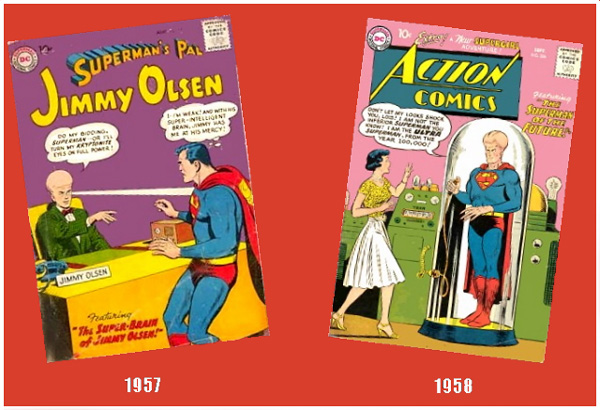 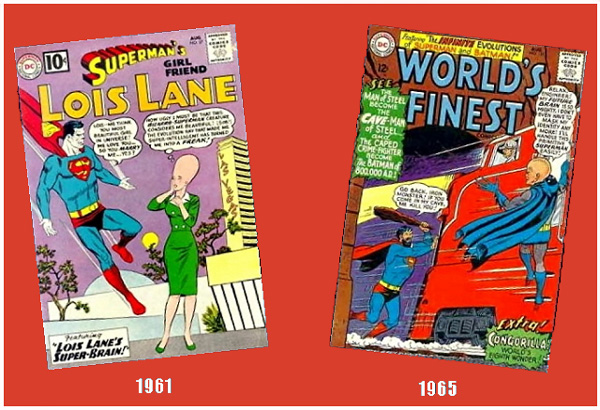
|
|
Lou (March 19, 2011) |
|
The Adventures Continue (TAC) is a website devoted to George Reeves and the Adventures of Superman. All contents copyright© by Jim Nolt unless otherwise noted. All rights reserved. Nothing from this website may be reproduced by any means, in whole or in part (excpet for brief passaged used solely for review purposes) without the written permission of either Jim Nolt (owner) and/or Lou Koza (editor). The items contained in the feature pages titled Alfred Walker's Basement by Alfred Walker is the copyright and ownership of Alfred Walker and cannot be reproduced by any means, in whole or in part without Mr. Walker's written permission. Superman and all related indicia are trademarks of DC Comics, Inc. and are reproduced for historical purposes only. Use of the name of any product or character without mention of trademark status should not be construed as a challenge to such status. Includes the video captures from the Adventures of Superman. |